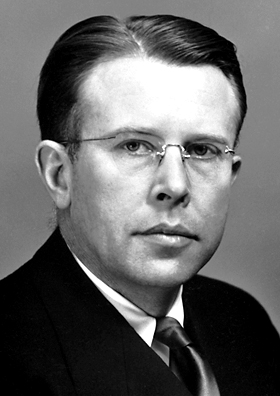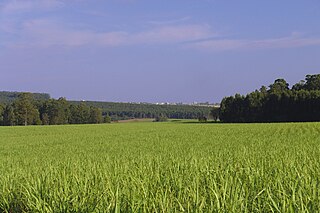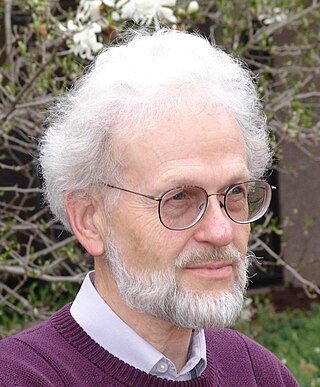Related Research Articles

Ernest Orlando Lawrence was an American nuclear physicist and winner of the Nobel Prize in Physics in 1939 for his invention of the cyclotron. He is known for his work on uranium-isotope separation for the Manhattan Project, as well as for founding the Lawrence Berkeley National Laboratory and the Lawrence Livermore National Laboratory.

Melvin Ellis Calvin was an American biochemist known for discovering the Calvin cycle along with Andrew Benson and James Bassham, for which he was awarded the 1961 Nobel Prize in Chemistry. He spent most of his five-decade career at the University of California, Berkeley.
A space sunshade or sunshield is a parasol that diverts or otherwise reduces some of the Sun's radiation, preventing it from hitting a spacecraft or planet and thereby reducing its insolation, which results in reduced heating. Light can be diverted by different methods. The concept of the construction of sunshade as a method of climate engineering dates back to the years 1923, 1929, 1957 and 1978 by the physicist Hermann Oberth. Space mirrors in orbit around the Earth with a diameter of 100 to 300 km, as designed by Hermann Oberth, are intended to focus sunlight on individual regions of the Earth’s surface or deflect it into space so that the solar radiation is weakened in a specifically controlled manner for individual regions on the Earth’s surface. First proposed in 1989, another space sunshade concept involves putting a large occulting disc, or technology of equivalent purpose, between the Earth and Sun.
Planetary engineering is the development and application of technology for the purpose of influencing the environment of a planet. Planetary engineering encompasses a variety of methods such as terraforming, seeding, and geoengineering.
Climate engineering is a term used for both carbon dioxide removal and solar radiation management, also called solar geoengineering, when applied at a planetary scale. However, they have very different geophysical characteristics which is why the Intergovernmental Panel on Climate Change no longer uses this overarching term. Carbon dioxide removal approaches are part of climate change mitigation. Solar geoengineering involves reflecting some sunlight back to space. All forms of geoengineering are not a standalone solution to climate change, but need to be coupled with other forms of climate change mitigation. Another approach to geoengineering is to increase the Earth's thermal emittance through passive radiative cooling.
Intellectual Ventures is an American private equity company that centers on the development and licensing of intellectual property. Intellectual Ventures is one of the top-five owners of U.S. patents, as of 2011. Its business model focuses on buying patents and aggregating those patents into a large patent portfolio and licensing these patents to third parties. The company has been described as the country's largest and most notorious patent trolling company, the ultimate patent troll, and the most hated company in tech.

Bioenergy is energy made or generated from biomass, which consists of recently living organisms, mainly plants. Types of biomass commonly used for bioenergy include wood, food crops such as corn, energy crops and waste from forests, yards, or farms. The IPCC defines bioenergy as a renewable form of energy. Bioenergy can either mitigate or increase greenhouse gas emissions. There is also agreement that local environmental impacts can be problematic.

Steven Chu is an American physicist and former government official. He is a Nobel laureate and was the 12th U.S. secretary of energy. He is currently the William R. Kenan Jr. Professor of Physics and Professor of Molecular and Cellular Physiology at Stanford University. He is known for his research at the University of California, Berkeley, and his research at Bell Laboratories and Stanford University regarding the cooling and trapping of atoms with laser light, for which he shared the 1997 Nobel Prize in Physics with Claude Cohen-Tannoudji and William Daniel Phillips.

The Ernest Orlando Lawrence Award was established in 1959 in honor of a scientist who helped elevate American physics to the status of world leader in the field.

The Virgin Earth Challenge was a competition offering a $25 million prize for whoever could demonstrate a commercially viable design which results in the permanent removal of greenhouse gases out of the Earth's atmosphere to contribute materially in global warming avoidance. The prize was conceived by Richard Branson, and was announced in London on 9 February 2007 by Branson and former US Vice President Al Gore.
Anastasios Melis is a Greek-American biologist at the University of California, Berkeley who elucidated the possibility of creating hydrogen from algae. He is currently Professor of Plant & Microbial Biology in the institution and Editor-in-Chief of the Planta journal.

David Robert Nygren is a particle physicist known for his invention of the time projection chamber. He is a Presidential Distinguished Professor of Physics, University of Texas at Arlington now. He has worked at Lawrence Berkeley National Laboratory since 1973. He has been called "the most distinguished developer of particle detection instruments in the country".
This is a list of climate change topics.

Solar geoengineering, or solar radiation modification (SRM), is a type of climate engineering in which sunlight would be reflected back to outer space to limit or offset human-caused climate change. There are multiple potential approaches, with stratospheric aerosol injection (SAI) being the most-studied method, followed by marine cloud brightening (MCB). Other methods have been proposed, including a variety of space-based approaches, but they are generally considered less viable, and are not taken seriously by the Intergovernmental Panel on Climate Change. SRM methods could have a rapid cooling effect on atmospheric temperature, but if the intervention were to suddenly stop for any reason, the cooling would soon stop as well. It is estimated that the cooling impact from SAI would cease 1–3 years after the last aerosol injection, while the impact from marine cloud brightening would disappear in just 10 days. Contrastingly, once any carbon dioxide is added to the atmosphere and not removed, its warming impact does not decrease for a century, and some of it will persist for hundreds to thousands of years. As such, solar geoengineering is not a substitute for reducing greenhouse gas emissions but would act as a temporary measure to limit warming while emissions of greenhouse gases are reduced and carbon dioxide is removed.

Arctic geoengineering is a type of climate engineering in which polar climate systems are intentionally manipulated to reduce the undesired impacts of climate change. As a proposed solution to climate change, arctic geoengineering is relatively new and has not been implemented on a large scale. It is based on the principle that Arctic albedo plays a significant role in regulating the Earth's temperature and that there are large-scale engineering solutions that can help maintain Earth's hemispheric albedo. According to researchers, projections of sea ice loss, when adjusted to account for recent rapid Arctic shrinkage, indicate that the Arctic will likely be free of summer sea ice sometime between 2059 and 2078. Advocates for Arctic geoengineering believe that climate engineering methods can be used to prevent this from happening.

Mark Zachary Jacobson is a professor of civil and environmental engineering at Stanford University and director of its Atmosphere/Energy Program. He is also a co-founder of the non-profit, Solutions Project.

Stratospheric aerosol injection is a proposed method of solar geoengineering to reduce global warming. This would introduce aerosols into the stratosphere to create a cooling effect via global dimming and increased albedo, which occurs naturally from volcanic winter. It appears that stratospheric aerosol injection, at a moderate intensity, could counter most changes to temperature and precipitation, take effect rapidly, have low direct implementation costs, and be reversible in its direct climatic effects. The Intergovernmental Panel on Climate Change concludes that it "is the most-researched [solar geoengineering] method, with high agreement that it could limit warming to below 1.5 °C (2.7 °F)." However, like other solar geoengineering approaches, stratospheric aerosol injection would do so imperfectly and other effects are possible, particularly if used in a suboptimal manner.
David W. Keith is a professor in the Department of the Geophysical Sciences at the University of Chicago. He joined the University of Chicago in April 2023. Keith previously served as the Gordon McKay Professor of Applied Physics for Harvard University's Paulson School of Engineering and Applied Sciences (SEAS) and professor of public policy for the Harvard Kennedy School at Harvard University. Early contributions include development of the first atom interferometer and a Fourier-transform spectrometer used by NASA to measure atmospheric temperature and radiation transfer from space.

Space mirrors are satellites that are designed to change the amount of solar radiation that impacts the Earth as a form of climate engineering. The concept was first theorised in 1923 by physicist Hermann Oberth and later developed in the 1980s by other scientists. Space mirrors can be used to increase or decrease the amount of solar energy that reaches a specific point of the earth for various purposes. They have been theorised as a method of solar geoengineering by creating a space sunshade to deflect sunlight and counter global warming.

Amit Goyal is a SUNY Distinguished Professor and a SUNY Empire Innovation Professor at SUNY-Buffalo. He leads the Laboratory for Heteroepitaxial Growth of Functional Materials & Devices. He is also Director of the New York State Center of Excellence in Plastics Recycling Research & Innovation, an externally funded center with initial funding of $4.5M for three years at SUNY-Buffalo. He is the founding director of the multidisciplinary and transdisciplinary RENEW Institute at SUNY-Buffalo in Buffalo, New York and served as director from 2015-2021. RENEW is an internally funded research institute at SUNY-Buffalo. For his contributions to UB, in 2019, he was awarded the University at Buffalo or SUNY-Buffalo President's Medal, which recognizes “outstanding scholarly or artistic achievements, humanitarian acts, contributions of time or treasure, exemplary leadership or any other major contribution to the development of the University at Buffalo and the quality of life in the UB community.” This is one of the highest recognitions given at the university.
References
- ↑ "Dr. Lowell Wood". marshall.org. George C. Marshall Institute. Archived from the original on 2012-02-21. Retrieved 2015-10-26.
- ↑ "U.S. Patent Office search for Lowell Wood". Archived from the original on 2019-01-14. Retrieved 2015-07-07.
- 1 2 3 Vance, Ashlee (2015-10-20). "How an F Student Became America's Most Prolific Inventor". bloomberg.com. Bloomberg Business . Retrieved 2015-10-26.
- ↑ "Hyperthermal processes in the solar atmosphere". UCLA Library Catalog. Retrieved January 27, 2014.
- ↑ Wood, Lowell. "Hyperthermal Processes in the Solar Atmosphere" . Retrieved January 26, 2014– via ProQuest.
- ↑ "Appendix: Biographies". The Carbon Dioxide Dilemma: Promising Technologies and Policies. Washington, DC: The National Academies Press. 2003. p. 130. doi:10.17226/10798. ISBN 978-0-309-08921-0.
- ↑ "The Ernest Orlando Lawrence Award Award Laureates". U.S. Department of Energy Office of Science. 28 December 2010.
- ↑ "Golden Plate Awardees of the American Academy of Achievement". www.achievement.org. American Academy of Achievement.